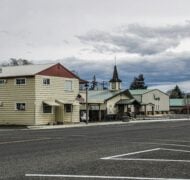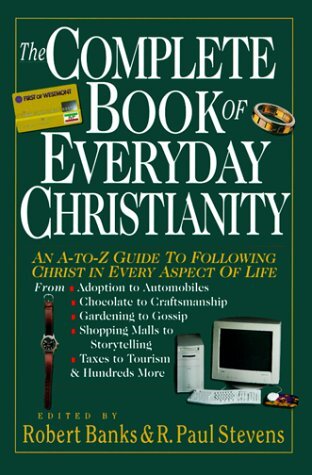Community, Rural
Book / Produced by partner of TOW
The lights of rural communities and villages flicker and die as farm families desert the countryside and those remaining drive past to the larger centers. Rugged individualism seems to be replacing the traditional cooperative spirit. But earth keeping and community are still mutually essential (Genesis 2:15-18; Leviticus 25-26; Bryden and Gertner, pp. 72, 211).
The Setting
Rural out-migration began after World War II (Riedel and Wefald, p. 108). Stimulus was provided by unprecedented mechanization and other technological development, which continues unabated today. Therefore people with acquisitive attitudes were and still are able to accumulate ever larger units of primary food production (Connick, Connick and Keating, pp. 57-61; Kneen, p. 76). The prophet Isaiah described well the situation: “Woe to you who add house to house and join field to field till . . . you live alone in the land” (Isaiah 5:8). The sparsely populated countryside we see today does not conform to the Lord’s decree to fill the earth (Genesis 9:7) nor to his scattering the people over the earth (Genesis 11:8).
A significant remnant of social support remains in rural community. In Canada, for example, 57 percent of rural people are directly involved in support networks from which 90 percent benefit (Apedaile et al., pp. 8-9). These involvements still provide some local vigor and stability (Apedaile et al., p. 22). Women, through their volunteer work and social networking, are the glue that holds rural communities together (Apedaile et al., pp. 7-8). Though most have off-farm jobs (Apedaile et al., p. 11), women remain the major producers of household goods for consumption and provide on-farm support and labor (compare Proverbs 31:10-31). In the Canadian province of Saskatchewan, traditionally a grain-growing rural economy, off-farm income of farm families exceeded net farm income by a substantial margin in 1991 (Apedaile et al., p. 11). Sixty percent of farm women and 30 percent of farm men had off-farm jobs.
The Decline
Rural people have sought out urban amenities of shopping, entertainment and recreation. Other less-edifying city attractions are the possibilities of anonymity, glitz, fast living and unmitigated materialism. Farm income cannot fulfill the desire for the luxuries available to city people. That, in combination with other factors including government encouragement, has resulted in the great exodus of country folk to the city (Freudenberger, p. 81).
Not only is the number of farmers and villagers small, but they are fractionalized by social and political differences. Therefore there is diminishing contact between rural neighbors, with little reason remaining to bring neighbors together, especially when rural commuting to a fifty-mile range is common.
Individualism, fueled by greed, is a big factor in the depopulation of the countryside. Individualism is not biblical (1 Cor. 12; Marshall, p. 142; Walsh and Middleton, p. 86). In the Bible direction from the Lord is usually toward a people, not individuals (Romans 12:3-5; Ephes. 4-5; Col. 3:5-17; 1 Peter 2:9-10). The strength of community is the complementary nature of unique gifting to individuals.
Rural Vulnerability
With the industrialization of the farm and depletion of the rural population has come considerable loss of connection to the earth. A rural life keeps one in touch with the land on which we all depend for sustenance. Knowing where food is grown lends one credibility. There is wisdom derived from knowing how the weather makes the production of food an uncertain matter. Above all, we hear from God through creation (Psalm 8; Psalm 19; Romans 1:20). Too many people live an aseptic, naive, disconnected-from-creation-and-its-reality existence to be good for society as a whole (Connick, Connick and Keating, pp. 235, 242).
With the current trend toward bigger farms, residents are becoming increasingly vulnerable. Obviously, personal and farm safety is a concern. Moreover, since farmers are now between 3 percent and 4 percent of the population, they have lost political significance (Freudenberger, p. 82). This small voting bloc is the one most in touch with the land from which we all receive our food and is ignored, therefore, at the peril of the nation (Riedel and Wefald, p. 109; Kneen, p. 83; Connick, Connick and Keating, p. 235; Bryden and Gertner, p. 73). Finally, when independence is the hallmark of a society, can social, government, health and school problems be far behind?
Alternatives: The Amish and the French
The Amish are well known for their counterculture. To give their young people a reprieve from the perceived degrading influence of the predominant culture, they have devised a lifestyle that keeps their children in the community (Dobson, p. 52; Goering, Norberg and Page, p. 59). The Amish have been successful in providing a place for their children in a rural setting, in part by resisting the use of motorized vehicles. They are committed to each other, and that has a remarkable socioeconomic impact. For instance, neighbors and family gather to raise a new barn. Insurance is not needed because the community is there to help.
In his book Global Dust Bowl, C. Dean Freudenberger describes how France, beginning in the 1960s, turned the nation back to traditional agriculture. The result has been a revitalizing of the rural community, growing rural-urban solidarity and an improved “health of its countryside” (Freudenberger, pp. 94-98).
Renewal
Near large cities there has been a recent in-migration of city workers to the country (Connick, Connick and Keating, p. 69). This has been a disruptive influence on farming, hastening the demise of the very best agricultural land through country residential development. Any plan to reverse the population shift in favor of rural areas must be approached carefully. The introduction of industrial development from outside only creates problems of commuting workers and resentment from local residents over outsiders’ taking jobs. Any project must be done from within the community with careful planning and education involving local residents and government (Riedel and Wefald, p. 113; Connick, Connick and Keating, p. 250).
An international group of researchers, the Agriculture and Rural Restructuring Group (the Group), has proposed that current government aid to a depressed rural economy be replaced with a system of direct payment for rural development and sustainability by something like a tax on food (Apedaile et al., p. 23). Most urbanites are willing to help the dwindling rural population maintain roads, sustain the countryside for the enjoyment of all and provide food. Another recommendation from the Group is that, given the consolidation of farms, there is need for growth in nonagricultural activity in rural areas to help stabilize the rural economy. The context of the proposal is “re-integration of family with business interests” (Apedaile et al., pp. 24, 27). Also proposed is a change from an emphasis on the diversification of on-farm enterprise to farmer and community diversification into nonagricultural pursuits.
Conclusion
A growth in rural population coming from an increase in the number of farms and rural businesses will benefit a nation. Any such move must take into account that the country offers a different set of benefits and experiences than does the city. While some might consider it a sacrifice to live in the country, there is substantial compensation to be living where true community is more likely and where ties to creation can be renewed.
» See also: City
» See also: Community
» See also: Gossip
» See also: Hospitality
» See also: Neighborhood
» See also: Small Towns
» See also: Visiting
References and Resources
P. Apedaile et al., Towards a Whole Rural Policy for Canada (Brandon, Man.: University of Brandon, Canadian Agriculture and Rural Restructuring Group, 1994); J. Bryden and M. E. Gertner, Towards Sustainable Rural Communities (Guelph, Ont.: University of Guelph, 1994); D. Connick, N. Connick and N. C. Keating, Alternative Futures for Prairie Agricultural Communities (Edmonton: University of Alberta, 1991); R. V. G. Dobson, Bringing the Economy Home from the Market (Montreal: Black Rose Books, 1993); C. D. Freudenberger, Global Dust Bowl (Minneapolis: Augsburg, 1990); P. Goering, H. Norberg and J. Page, From the Ground Up (London: Zed, 1993); B. Kneen, From Land to Mouth (Toronto: NC Press, 1989); P. Marshall, Thine Is the Kingdom (Basingstoke, Hants, U.K.: Marshalls, 1984); R. Riedel and J. Wefald, “Strengthening Rural Communities,” in Farming the Lord’s Land, ed. E. Lutz (Minneapolis: Augsburg, 1980); B. Walsh and R. Middleton, The Transforming Vision (Downers Grove, Ill.: InterVarsity Press, 1984).
—Verne M. Gleddie





